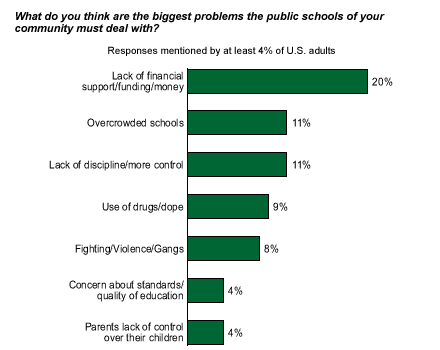For the last several years, inadequate funding has been the biggest problem Americans say public schools in their communities must contend with. According to the 2005 Phi Delta Kappa/Gallup survey*, this problem hasn't been devalued. Twenty percent of Americans say lack of money is the biggest problem the public schools in their communities must deal with. Overcrowded schools, discipline issues, use of drugs, and violence, each mentioned by roughly 10% of Americans, are all distant runners-up.

Nonwhite Americans are the only demographic group surveyed that is more likely to see another problem as bigger than funding. Nineteen percent of nonwhite respondents say fighting, violence, and gang problems are the biggest problems their community schools deal with, compared with 6% of whites who say those issues are the biggest problems.
Why So Much Concern About Funding?
Not surprisingly, worries about school funding became more prevalent after the economic boom screeched to a halt in the late 1990s. Many school districts found themselves with less state aid resulting from serious budget cuts at a time when the cost of a high-quality education was rising dramatically. "There's a significant shortfall in federal funds causing a great shift in budget priorities for the states," says Reggie Felton, director of federal relations at the National School Board Association (NSBA) in Alexandria, Va. "While the No Child Left Behind Act covers the cost of testing, the reporting requirement forced schools to upgrade their information technology systems, and that's a huge cost."
"Schools are being asked to fulfill larger roles and those needs are more expensive," says Rebecca Gorrell, chair of the math department at Lakewood, Colo., middle school. "For instance, a quality education now includes graphing calculators for every student and computers with Internet connections in every classroom. The technology budget alone is up tenfold in the last decade."
Bottom Line
Despite the public's concern about inadequate funding for public schools, no one would suggest that money can solve every educational issue. Gorrell, however, would still welcome it and thinks it can solve many problems. "Money can reduce class size and that's great -- more one-on-one time with the teacher is always a good thing," she says. "Additional funding can also offer teachers better salaries, especially math and science teachers, so they'll stay in education and not take higher-paying jobs in research and private industry."
But there are many things money won't buy, Gorrell says. "Money won't bring back the two-parent family, change the cultural views toward education and educators, or induce teachers who are stuck in their old-style ruts to take advantage of staff development and change their methods."
*This article contains findings from the 37th Annual Phi Delta Kappa/Gallup Poll of the Public's Attitudes Toward the Public Schools, released on Aug. 23 in Washington, D.C.
The findings of the survey are based on telephone interviews with a random sample of 1,000 U.S. adults, aged 18 and older, conducted from June 9-26, 2005. For results based on this sample, one can say with 95% confidence that the maximum error attributable to sampling and other random effects is ± 3 percentage points.